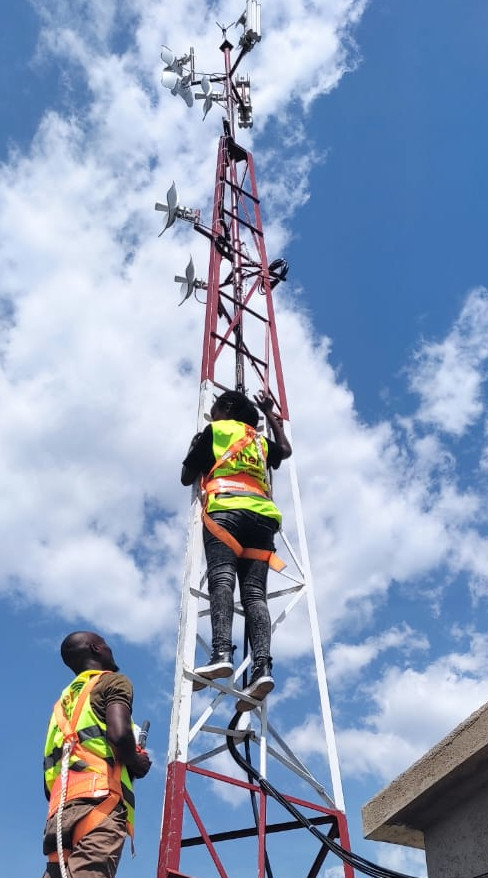The Kenya National School of Community Networks convened on 28th February and ended on 4th March 2022. The 21 participants from seven community networks underwent rigorous training in areas of:
- Network Infrastructure and services
- Policy and Regulations
- Sustainability
Each Community network had three representatives each of whom had to attend training sessions in one of the focus areas. Training sessions were conducted by experts who took on a participatory approach which built into productive interactive sessions.
Network Infrastructure and services
Community networks are mainly deployed using wireless technologies. The networks mostly use unlicensed spectrum in the Industrial, Scientific and Medical (ISM) band 2.4GHz and 5GHz frequencies. After recommendations from the Dynamic Spectrum Alliance (DSA), Global System for Mobile Communications Association (GSMA), African Telecommunications Union (ATU), and Communication Authority of Kenya (CA) has plans underway to authorize use of lower parts of the 6 GHz band for unlicensed use to reduce interference and enhance connectivity.
Community networks can use either of the following wireless technologies in deploying their networks:
- Wi-Max
- Wi-Fi
- Cellular networks (LTE)
- TV White Spaces
It is important to do a viability study before implementation of your community network. Important points to consider in the study are:
- The physical infrastructure (such as masts and the possibility of sharing )
- The technical infrastructure (such as radios to avoid network interference.)
- Proximity to backhaul
- Type of terrain
- Population density (sparse or dense (e.g. equipment importation laws, licensing requirements, etc.)
The Communications Authority of Kenya (CA) recently approved use of TVWS , a technology that utilizes portions of spectrum unused by TV broadcasting services, mostly in the UHF band (TV frequency), also known as “buffer channels”. TVWS technology is as yet unexplored but carries with it much potential since it can cover an area of about 10km (Wi-Fi covers 50 – 100 meters), does not require line of sight and can penetrate obstacles making it suitable for rugged terrain.
Policy and Regulations
Policy and regulations was an especially important area of discussion since many community networks were not aware of the policies regulating their operations.
Community networks as a new approach to connecting unserved and underserved communities had not been legally recognized in Kenya until 2021 when CA collaborated with KICTANet, APC and University of Strathclyde Glasgow-Scotland with support from United Kingdom’s Digital Access Program to develop an inclusive framework for community networks.
This led to Development of a Community Network Service Provider License (CNSP) under the unified licensing framework. The license is given for a period of 10 years, renewable 6 months before expiry. The license has an application fee of Kshs.1000 ($10), and an annual operating fee of Kshs. 5000 ($50). CNSP holders are exempted from USF (Universal Service Fund) contributions. However, should the community network expand beyond the boundaries of a sub county, they will be required to apply for the ASP (Application Service Provider) license, which is what AheriNet – our host Community Network for the event – has done as they now cover (Kisumu, Homabay and Siaya counties).
It is important to note that CA allows sharing of infrastructure such as masts as long as the parties have a written agreement presented to CA.
Sustainability
Sustainability sessions focused on community ownership, leadership, financial management and technology. Community networks provide last mile and complementary approach to bridging the digital divide. They focus on the social well-being of a community rather than profit maximization. It is therefore important for the community to feel ownership of the project through involvement in the organizational structure, program selection and content development. A sense of ownership by the community builds loyalty, a vital tool to sustainability.
A community network’s continuity should be independent of its leadership. Leadership autonomy kills the project when only one person is responsible for making decisions. Leadership skills should trickle down the organizational structure to ensure continuity of the project in the absence of the key leader.
Financial management determines if a community network can sustain its operations and if they are eligible for grants. It has 7 key principles:
- Consistency
- Accountability
- Transparency
- Viability
- Integrity
- Stewardship
- Accounting
These principles should guide the processes of writing grant proposals, grant management, documentation, auditing and reporting. Donors are also guided by these principles in determining how an organization scores for eligibility to receive grants.
The choice of technology used to connect the community will determine the consistency of connection. This is especially important when the Community network has businesses that rely on dedicated access during office hours like hospitals, NGOs and schools.
Resolutions of the training.
To carry on the rich context of the school, there are plans to publish a handbook entailing all sections of the training in detail.
Participants agreed to form a consortium. The consortium will give more bargaining power to the community networks in negotiating for better policies while collaborating with KICTANet, the ICT advocacy giant in the region.
Final is to continue the exchanges that have sprung from this convening to push the movement of community networks all over the country.
This is a series of our publications on Community Networks.
Catherine Kyalo is the Africa Regional Coordinator at KICTANet for APC-LOCNET initiative. She is passionate about community welfare and enjoys yoga to rejuvenate. LinkedIn: www.linkedin.com/in/catherine-kyalo Twitter: @Kyalo84Kyalo
![]()




